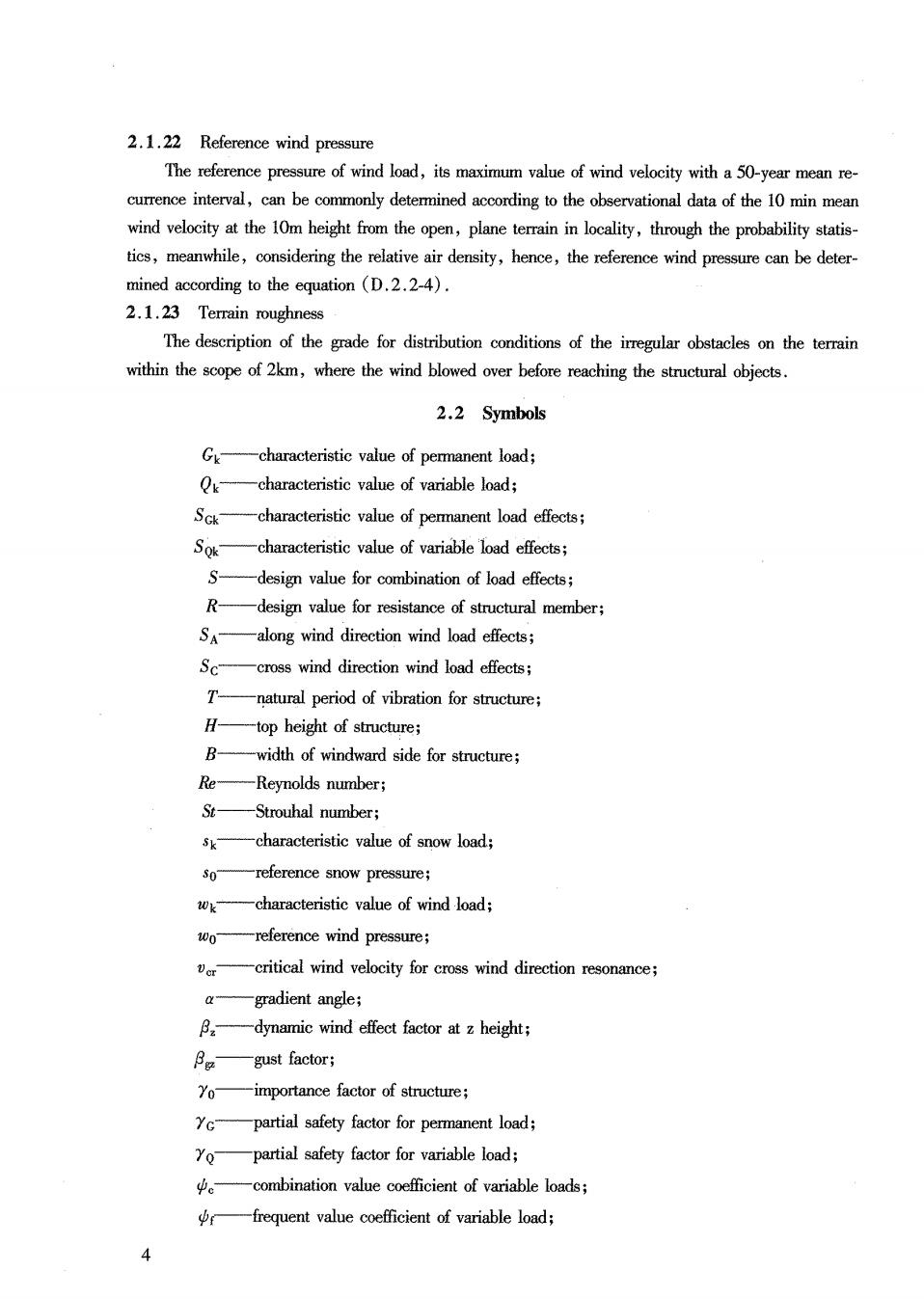
2.1.22 Reference wind pressure The reference pressure of wind load,its maximum value of wind velocity with a 50-year mean re currence interval,can be commonly determined according to the observational data of the 10 min mear wind velocity at the 10m height from the open,plane terrain in locality,through the probability statis- tics,meanwhile,considering the relative air density,hence,the reference wind pressure can be deter mined according to the equation (D.2.2-4) 2.1.23 Terrain roughness The description of the grade for distribution conditions of the iregular obstacles on the terrain within the scope of 2km,where the wind blowed over before reaching the structural objects 2.2 Symbols G -characteristic value of permanent load; 0k- -characteristic value of variable load; SGk -characteristic value of permanent load effects; Sok characteristic value of variable load effects; design value for combnation of oad ffect R-design value for resistance of structural member; SA- along wind direction wind load effects; Sc- wind direction wind load effects; T natural period of vibration for structure; H -top height of structure; B width of windward side for structure; Re- -Reynolds number; Strouhal number; Sk -characteristic value of snow load; 50 -reference snow pressure; wcharacteristic value of wind load; 0a- reference wind pressure; critical wind velocity for cross wind direction resonace -gradient angle; wind effect factor at z height; —gust factor; Yo -importance factor of structure; yc-partial safety factor for permanent load; Yo-partial safety factor for variable load; 中。 -combination alue cofficient of variable oads -frequent value coefficient of variable load;
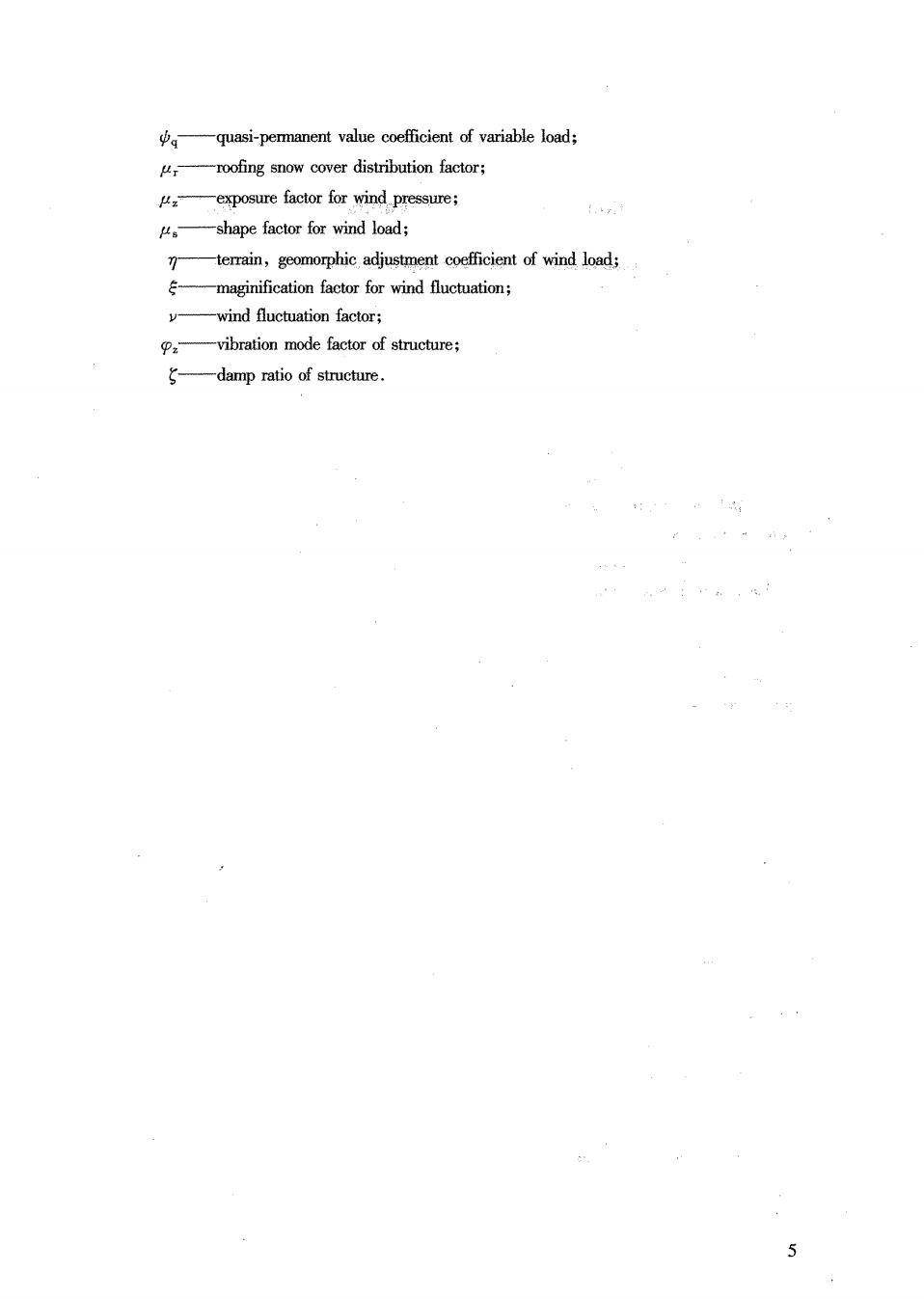
quasi-pemmanent value coefficient of variable load; roofing snow cover distribution factor; exposure factor for wind pressure; k。—-shape factor for wind load; maginification factor for wind fluctuation; -wind fluctuation factor; vibration mode factor of structure; damp ratio of structure
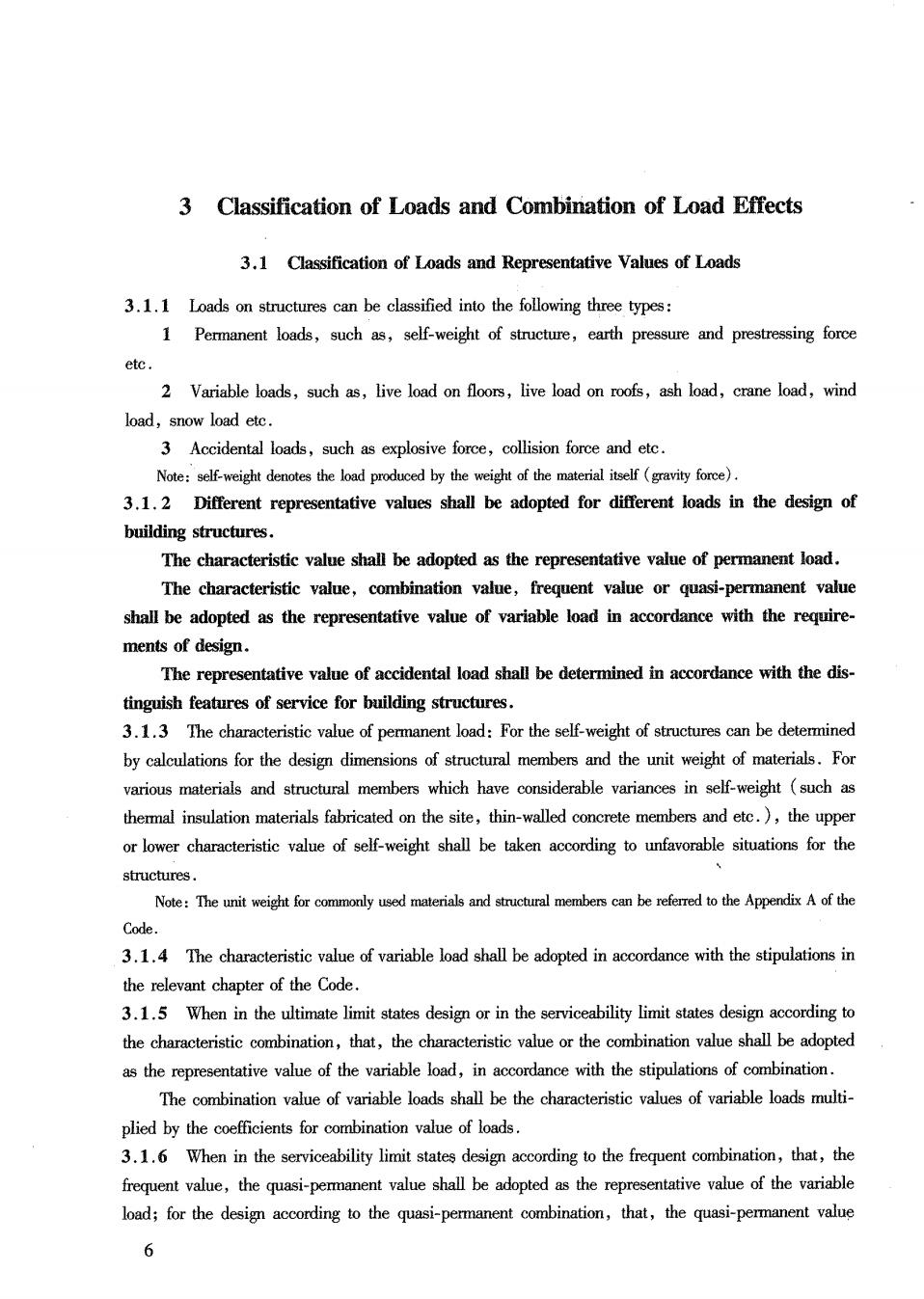
3 Classification of Loads and Combination of Load Effects 3.1 Classification of Loads and Representative Values of Loads 3.1.1 Loads on structures can be classified into the following three types: 1 Permanent loads,such as,self-weight of structure,earth pressure and prestressing force etc. 2 Variable loads,such as,live load on floors,live load on roofs,ash load,crane load,wind load,snow load etc. 3 Accidental loads,such as explosive force,collision force and etc. Note:sef-weight denotes the load produced by the weight of the material itself (gavity fore). 3.1.2 Different representative values shall be adopted for different loads in the design of building structures. The characteristic value shall be adopted as the representative value of permanent load. The characteristic value,combination value,frequent value or quasi-permanent value shall be adopted as the representative value of variable load in accordance with the require- ments of design. The representative value of accidental load shall be determined in accordance with the dis- tinguish features of service for building structures. by calculations for the design dimensions of structural members and the unit weight of materials.For various materials and structural members which have considerable variances in self-weight (such as thermal insulation materials fabricated on the site,thin-walled concrete members and etc.),the upper or lower characteristic value of self-weight shall be taken according to unfavorable situations for the structures. Code. 3.1.4 The characteristic value of variable load shall be adopted in accordance with the stipulations in the relevant chapter of the Code. 3.1.5 When in the ultimate limit states design or in the serviceability limit states design according to the characteristic,that,the characteristic value or the combination value shall be adopted as the representative value of the variable load,in accrdance with the stipulations of combination. The combination value of variable loads shall be the characteristic values of variable loads multi plied by the coefficients for combination value of loads. 3.1.6 When in the serviceability limit states design according to the frequent combination,that,the frequent value,the quasi-permanent value shall be adopted as the representative value of the variable load;for the design according to the quasi-permanent combination,that,the quasi-permanent value 6
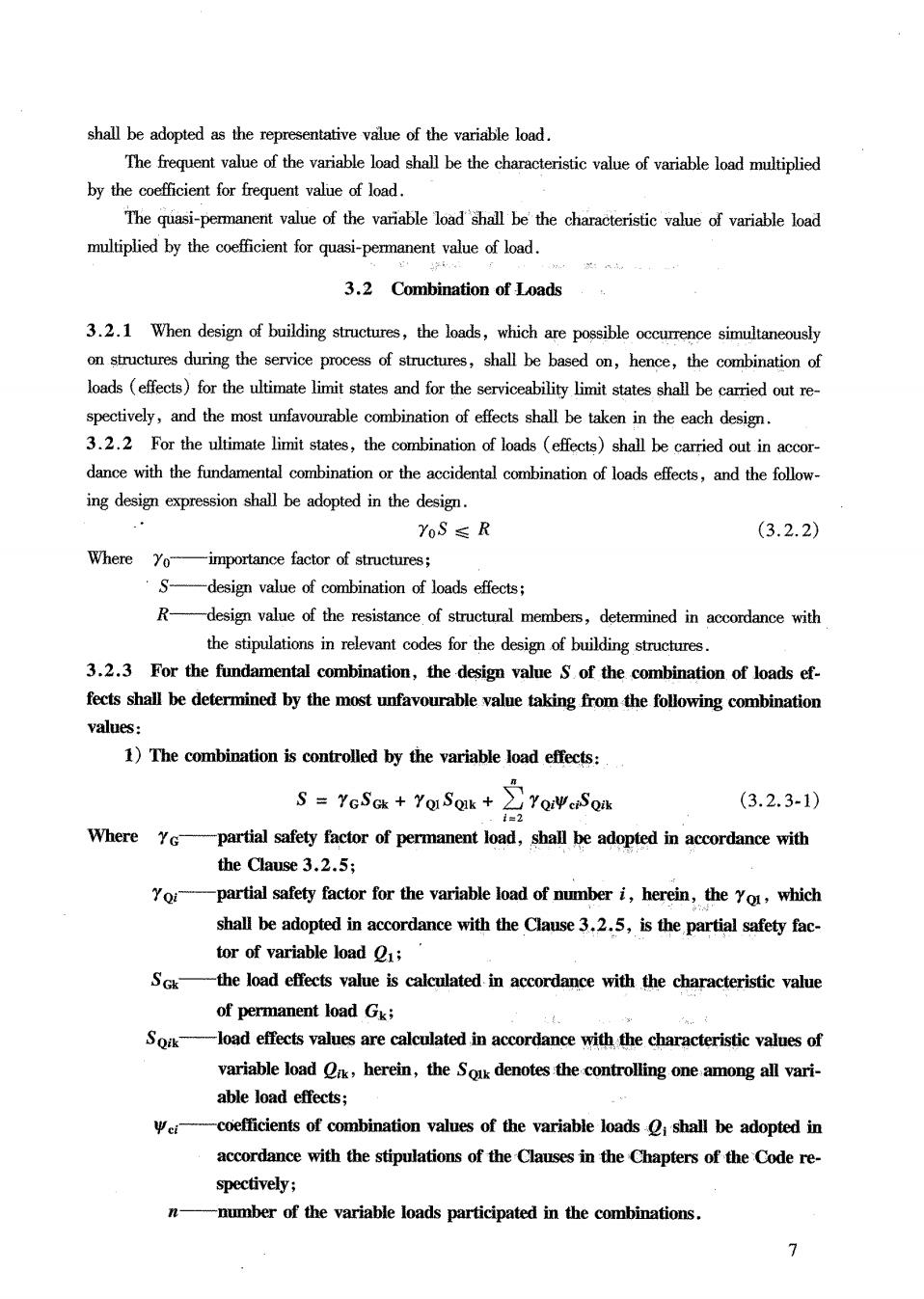
shall be adopted as the representative value of the variable load. The frequent value of the variable load shall be the characteristic alue of variable load multiplied by the coefficient for frequent value of load. The quasi-permanent value of the variable load shall be the characteristic value of variable load multiplied by the coefficient for quasi-permanent value of load. 3.2 Combination of Loads 3.2.1 When design of building structures,the loads,which are possible occurrence simultaneously onuctures during the service process of structures,shall be based on,hence,the combination of loads (effects)for the ultimate limit states and for the serviceability limit states shall be carried out re spectively,and the most unfavourable combination of effects shall be taken in the each design. 3.2.2 For the ultimate limit states,the combination of loads (effects)shall be carried out in accor dance with the fundamental combination or the accidental combination of loads ffects,and the follow- ing design shall be adopted in the design. YoS≤R (3.2.2) Where Yoimportance factor of structures; S-design value of combination of loads effects: R-design value of the resistance of structural members,determined in accordance with the stipulations in relevant codes for the design of building structures 3.2.3 For the fundamental combination,the design value S of the combination of loads ef- fects shall be determined by the most unfavourable value taking from the following combination values: 1)The combination is controlled by the variable load effects: 5=7ga+as+盒oY./ow (3.2.3-1) Where YG -partial safety factor of permanent load,shall be adopted in accordance with the Clause 3.2.5; -partial safety factor for the variable load of umberi,herein,the o which shall be adopted in accordance with the Clause 3.2.5,is the partial safety fac- tor of variable load -the load effects value is calculated in accordance with the characteristic value of permanent load Gx; -load effects values are calculated in accordance with the characteristic values of variable load On,herein,the Soik denotes the controlling one among all vari- able load effects; -coefficients of combination values of the variable loads shall be adopted in accordance with the stipulations of the Clauses in the Chapters of the Code re- spectively -number of the variable loads participated in the combinations
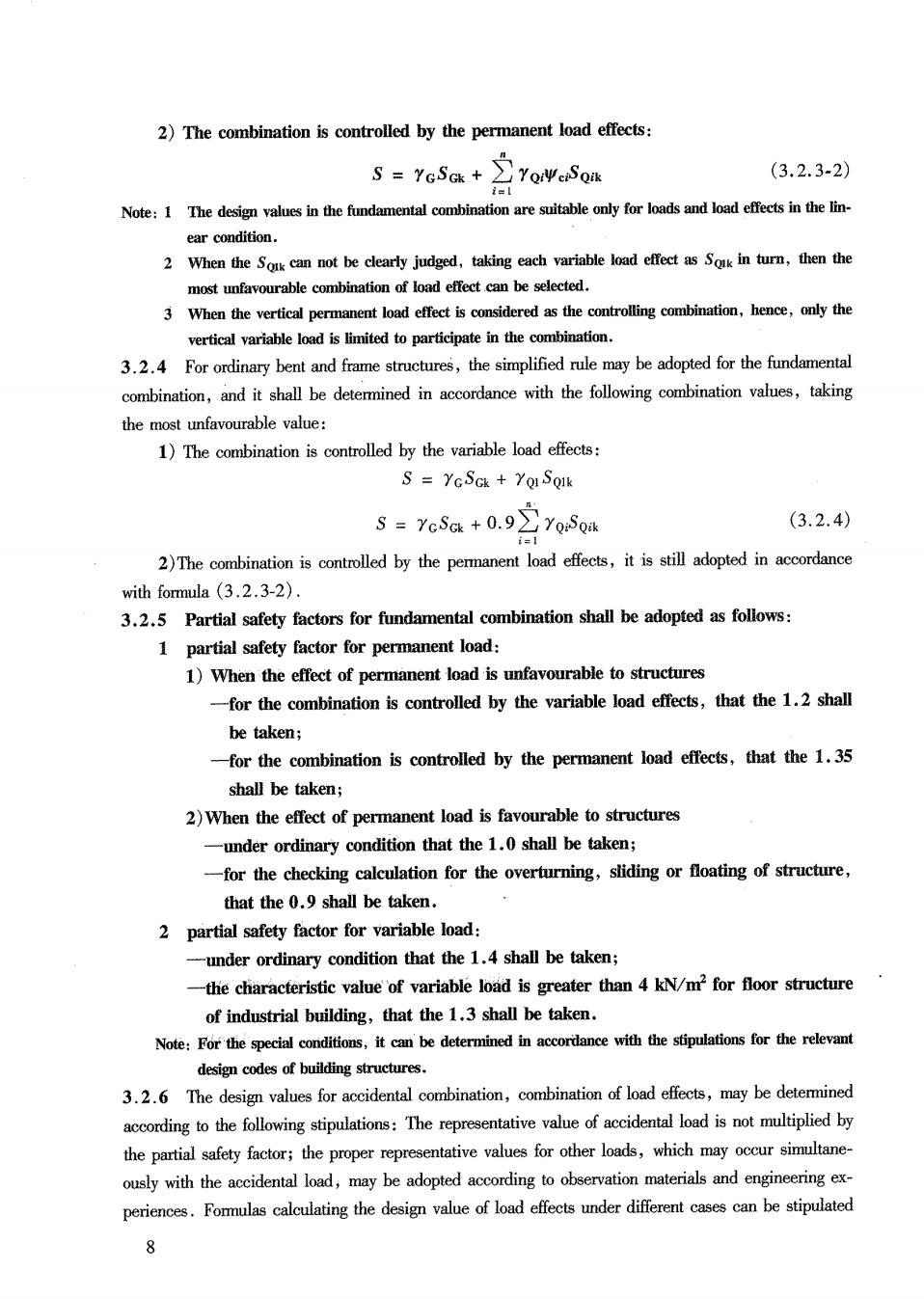
2)The combination is controlled by the permanent load effects: 5-YaS+oon (3.2.3-2) Note:1 The design valucs in the fundamental combination are suitableny for loads and load effects in the lin- 2 When theScan not be cearly judged,taking each variable oad efectasSintur then the most unfavourable combination of load effectc be selected. 3When the vertical permanent oad as,only the vertica variable ad is imited to participate in thecombination. 3.2.4 For ordinary bent and frame structures,the simplified rule may be adopted for the fundamental combination,and it shall be determined in accordance with the following combination values,taking the most: 1)The combination is controlled by the variable load effects: S YcSck Yo Soik s=%a+0.92yot (3.2.4) 2)The combination is controlled by the permanent load effects,it is still adopted in accordance with formula (3.2.3-2) 3.2.5 Partial safety factors for fundamental combination shall be adopted as follows: 1 partial safety factor for permanent load: 1)When the effect of permanent load is unfavourable to structures -for the combination is controlled by the variable load effects,that the 1.2 shall be taken; -for the combination is controlled by the permanent load effects,that the 1.35 shall be taken; 2)When the effect of permanent load is favourable to structures -under ordinary condition that the 1.0 shall be taken; -for the checking calculation for the overturning,sliding or floating of structure, that the 0.9 shall be taken. 2 partial safety factor for variable load: -under ordinary condition that the 1.4 shall be taken; the characteristic value of variable load is greater than 4 kN/m for floor structure of industrial building,that the 1.3 shall be taken Note:For the,itbe determined with the stipulationsfor the reevant design codes of building structures. 3.2.6 The design valuesfor accidental combination,combination of oad effects,may be determined according to the following stipulations:The representative value of accidental load is not multiplied by the partial safety factor;the proper representative values for other loads,which may ously with the accidental load,may be adopted according to observation materials and engineering ex- periences.Fomulas calculating the design value of load effects under different cases can be stipulated 8